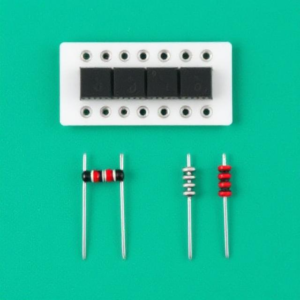Pull-up and Pull-down resistors in an easy-to-understand way.
What are Pull-up and Pull-down Resistors?
They are just resistors used in digital circuits to make sure that a signal stays either HIGH or LOW, even when it’s not being actively driven by something else (like a microcontroller or a sensor). These resistors help avoid erratic or unpredictable behavior in the circuit.

Digital Signals (HIGH vs LOW):
- HIGH means a signal is at a higher voltage, usually 3.3V or 5V, depending on the system.
- LOW means a signal is at 0V (ground).
Problem:
Imagine you have a circuit where you need a signal to be either HIGH or LOW, but there’s nothing actively setting the value. If the wire is just floating, the signal could randomly pick up noise and might be unstable (you get unpredictable results). This is where Pull-up and Pull-down resistors come in.
Pull-up Resistor:
A Pull-up resistor is a resistor connected between the signal line and the positive voltage (often called Vcc).
- Purpose: It “pulls” the signal to a HIGH level (positive voltage) when no other device is driving it.
- How it works: When the line is not actively being used, the pull-up resistor ensures the signal stays HIGH.
- Example: If you have a button connected to a microcontroller, when the button is not pressed, the pull-up resistor will make sure the input signal reads HIGH.
Example of Pull-up resistor circuit:
Vcc (5V) ----> [Pull-up Resistor] ----> Signal Line ----> (to device like microcontroller)
|
(Button to ground)
When the button is not pressed, the signal is HIGH (due to the pull-up). When the button is pressed, it connects the signal to LOW (ground).
Pull-down Resistor:
A Pull-down resistor is a resistor connected between the signal line and ground (0V).
- Purpose: It “pulls” the signal to a LOW level (0V) when no other device is driving it.
- How it works: When the line is not actively being used, the pull-down resistor ensures the signal stays LOW.
- Example: In the case of a button, when it’s not pressed, the pull-down resistor makes sure the input reads LOW.
Example of Pull-down resistor circuit:
Signal Line ----> [Pull-down Resistor] ----> Ground (0V)
|
(Button to Vcc)
When the button is not pressed, the signal is LOW (due to the pull-down). When the button is pressed, it connects the signal to HIGH (Vcc).
Key Differences:
- Pull-up Resistor: Ensures the signal is HIGH when not in use.
- Pull-down Resistor: Ensures the signal is LOW when not in use.
When to Use:
- Pull-up resistor is commonly used when you want a signal to default to a HIGH state (for example, with buttons that pull to ground when pressed).
- Pull-down resistor is used when you want a signal to default to LOW (for example, when you want to read a LOW value when a button is not pressed).
Why Do We Need Them?
They are needed to prevent “floating” signals, where the input line is left in an undefined state, causing incorrect or unpredictable behavior in your digital circuits.
summary:
- Pull-up resistor connects to Vcc (HIGH).
- Pull-down resistor connects to ground (LOW).
Tags: button circuit, button debounce, circuit design, Digital circuits, digital input, digital signal control, Electronic Components, electronics basics, floating signal prevention, ground connection, ground pull-down, HIGH signal, input pin, LOW signal, microcontroller input, Noise reduction, prevent erratic signals, pull-down resistor, pull-up resistor, pull-up vs pull-down, Resistor, resistor function, Signal Conditioning, signal default state, signal stabilization, stable voltage level, Vcc connection, voltage pull-up


